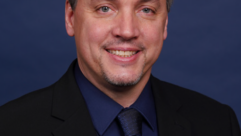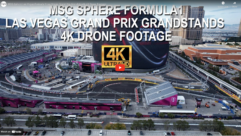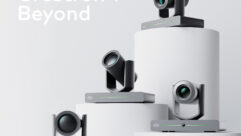
Passion 2013 Conference, Part 1
Apr 4, 2013 11:14 AM,
With Bennett Liles

Listen to the Podcasts
|
Editor’s note: For your convenience, this transcription of the podcast includes timestamps. If you are listening to the podcast and reading its accompanying transcription, you can use the timestamps to jump to any part of the audio podcast by simply dragging the slider on the podcast to the time indicated in the transcription.

One of the biggest events to hit Atlanta’s Georgia Dome this year was Passion 2013, a religious gathering reaching out to students and young adults. The big show called in TNDV Television to provide 23 cameras, live web coverage, and big screen feeds. TNDV Technical Manager Nic Dugger is here to tell us all about it, coming right up on the SVC Podcast.
Nic, thanks for being with us on the SVC Podcast with TNDV Television. Your crew had a huge remote, in fact I think it took two of your biggest trucks, at Atlanta’s Georgia Dome recently, the Passion 2013 Conference. A lot of singing and praying and music and TNDV Television was there to feed huge LED screens and a whole lot more. Before we get into all that though, tell me something about TNDV Television. What’s been happening there lately? Absolutely. Well, it’s a pleasure to be here with you. TNDV has been in business for just under nine years now. We’re based in Nashville, Tenn., and we started with one engineer and one small SD truck, and in just a few short years we’ve grown into a company with five mobile trucks now and a staff of six full-time truck engineers. And we’re excited to be launching our newest truck coming up. We have a new audio truck coming online. So in addition to all of our video and production work, we also do a lot of entertainment-based events. Last year we averaged just over 150 truck shoots, so we stay very busy. [Timestamp: 1:49]
Sure sounds like it. Back in the days when I used to do TV audio it was a little weird to even request a separate truck just for sound, but these days that can be the tail that wags the dog sometimes.
Very much so. That’s something that a few years ago I wouldn’t have even considered an audio truck, but because of the scale of shows that we’re doing is growing and growing and input lists are exploding, we decided to build a new audio truck that’ll hit the road in just a few weeks, and it rolls with 256 inputs to start. We’ll probably grow from there, and with any luck, we’ll have this audio truck at one of the Passion Conferences in years to come. [Timestamp: 2:25]
Well, it sounds as though on this remote you may have used just about all those sound inputs. What was Passion 2013 at the Georgia Dome?
The Passion Conference is a week-long youth religious retreat of sorts. It’s a week made up of small group meetings and very large group meetings. The large group meetings happen to take place inside a large venue. This year it was the Georgia Dome, which seats approximately 60,000. And it was in the round, so we sat around 60,000 folks. The floor was full and all the seats were full in this NFL Super Bowl-sized arena. And TNDV was primarily responsible for the cameras and the video system to not only broadcast the event, but to provide feeds for the inhouse video boards and the web stream and what will ultimately get converted into a DVD product that’s available. We supplied crew in the lines of camera operators and technical engineers in the truck and all of the camera systems themselves, of which there were quite a few. [Timestamp: 3:29]
You mentioned the Super Bowl and the Georgia Dome could certainly hold a Super Bowl, but you actually outdid them a little bit on the cameras. You had a few more than even that used.
There’s a rumor. You know, we were in New Orleans this year for the Super Bowl. I was not actually onsite at the arena, but I heard they had 22 cameras that were primarily responsible for the Super Bowl. This year at Passion 2013 I had 23 cameras, and that’s not including POV or small specialty cameras. These were 23 actual truck cameras on SMPTE fiber that went from the truck to the various locations all over the dome. So we had 23 real cameras, and it felt like doing the Super Bowl. The only difference is we had a lot less time to set it up and we did it for four-and-a-half days, not just a single game. So it was logistically opportunistic. [Timestamp: 4:22]
Right in the middle of the Dome there were some huge LED screens. As you said, it was done in the round and that introduces a whole new physical dimension to coverage of this event.
It was challenging. The video boards in particular were a challenge first of all because of the number of them. There were actually six primary LED boards and in addition to those six there were also ribbon screens that went along the edge of the seating throughout the arena that got a feed. And there was also some custom LED products, some soft goods, a pixel curtain in the center of the stage, not to mention plasma screens located throughout the venue and all over the show floor. The trick being almost none of these were a traditional aspect. You know, a 16×9 1080i aspect would simple, and that is what we streamed to the web, but the LED boards, we had three separate aspects we had to shoot for. So the video boards running the length of the field that were hung in the center were one aspect. The video boards that were on the field on the end caps of the hanging rig were another aspect, and then the two video boards that were built into the facility itself that they use for football games, were a third aspect. So you add the traditional 1080i aspect ratio to that, and that was four different screen sizes we had to frame for, which made it very challenging for our camera operators and very tricky for our director, TD, and AD’s working out in the trucks. [Timestamp: 5:51]
Passion 2013 Conference, Part 1
Apr 4, 2013 11:14 AM,
With Bennett Liles

The staging for this thing was massive, but you were also doing a live web feed with, I would think, different sources going to that than were being fed to the big LED screens and ribbon displays in the dome. Did you have one truck handling the online show and the other one doing the other feeds?
We did. The two primary trucks each had a specific function and shared the cameras between them. Our larger expanding-side truck, “Aspiration,” was primarily responsible for the screen feed, which some would assume might be the secondary concern. But because there were so many destinations and so many different aspects, it took the priority and got the larger truck with the larger switcher. Our secondary truck—our 40ft. straight truck, “Inspiration,”—switched the Web feed. Both trucks received all 23 cameras. Both directors had full ability to communicate with each of the cameras, but the camera operators were able to keep up with who was using their feed by their tally light system. We integrated a multi-colored tally light system that gave the camera operators a red tally light if they were on an LED videoboard, a green tally light if they were on the Web, and a yellow tally light if they happened to be being used on both. And this made sure that all the truck staff, by watching their multiviewers, and the camera operators by watching their tally, were aware of who was live, when, and for how long. [Timestamp: 7:10]
And all that can be real easy to get totally messed up when everything gets going in the complexity of this. So little time to get in and get it all set up and make sure everything is working right. There were some very long cable runs. The Georgia Dome is a huge place so what type of video signal cabling did you run to the cameras?
The cameras were actually a SMPTE fiber-based product from Hitachi, and what that SMPTE fiber cable allows us to do is run great distances. But it’s still a single cable, much like triax that we were all used to for so long, but this is an optical fiber cable which gives me a little bit better reassurance about the signal integrity and the distances we can run. To get from the truck to the field was 500ft, and that 500ft. went through the drop ceiling of their security offices, through an air conditioning duct that was large enough for someone to walk through, and through two different corridors. So just the first 500ft. was tricky, and from there you’re only on the edge of the field. It was still a minimum of 500ft. to any other camera location. Many cameras were 1,500 or 2,000 total linear feet away from the truck, but because of that SMPTE fiber cable we were still able to shade, have full intercom communications, send return video and get great looking HD video back from the cameras with no problems. [Timestamp: 8:31]
I’ve seen the existing ribbon displays in the dome. Was there anything you fed to the inhouse system or was all of this set up by your team from the beginning?
In addition to the concourse plasma screens, we also fed the ribbon boards and all of the VIP suites. We did that with the aid of a Spyder video switcher that was located in front of house. It took care of some of that aspect resolution management for us. But all of the signals did originate from the truck, and we used a series of tactical fiber cables and the FiDO brick product from AJA Video to get HD-SDI from the truck inside the venue, approximately 1,000ft., and back out to the truck again. So the SMPTE fiber camera cables, along with our tactical fiber and AJA FiDO bricks, and our copper infrastructure for our intercom we used an Adam frame from RTS for intercom. And we had 10 key-panel intercom stations at front of house in addition to all of the key panel user stations in the truck, in addition to all of the traditional party-line intercom, to make sure that the venue was able to communicate with the truck effectively.
And the trucks were equipped with what type of routers?
We used routers from Harris. We have their platinum series routers, which we used in every possible way on this show. Not only do the platinum routers have their multiviewers integrated, in other words any signal that hits the router is available to be displayed on a multiviewer that you can control tally, UMD, any kind of scaling of the picture-in-picture elements, and there’s also some interactive elements. We were able to hyperactively place logos, so we were able to put Passion logos on the multiviewers. We were able to display live incoming RSS feeds, so I was able to have a scroll of tweets and Twitter accounts that were being used to mention things about the event all live on one of 12 discrete and custom multiviewers we built. So not only did the front monitor wall have custom multiviewers, we also allowed our producers to build multiviewers just for themselves or front of house. Our shaders in the truck, of which there were four, were able to build multiviewers showing the cameras they were working on, and even in our audio suites in the truck we were able to assemble a custom multiviewer, so our audio engineers were able to monitor the cameras that were relevant to them. [Timestamp: 10:45]
This show required a lot of people to handle. How many people were on your tech crew doing all these things?
You know, we’ve attempted to count that, and I don’t think anybody’s come up with a final number yet. But between two directors, AD’s, TD’s, 23 camera operators with grips and utilities, four shaders, three engineer-in-charge, a tech manager or two, and a host of A2’s and utilities—we had an army. We had an excellent team that was able to deploy this massive video system in less than a day, I might add. We didn’t gain access to the venue until around 2:00 a.m. on the day where doors opened for our first show at 6:00 p.m. So it was a long day, but essentially less than a day to load this entire video system in, and I’m proud to say now that we’re not onsite and I can’t jinx us, it worked flawlessly. We had everything that we expected to have on day one and we were even able to go in on day two and make some modifications and adjust lensing. But everything worked great on that first day. So we started at 2:00 a.m. and opened doors to the public at 6:00 p.m. and kicked off the week right. [Timestamp: 11:51]
All right. Nic Dugger, technical manager with TNDV Television in Nashville. It was a great event, Passion 2013 at the Georgia Dome, with little time to set up and a whole bunch to do. In part two we’ll get into the intercom setup and the audio feeds. It was great to have you here and thanks for taking us behind the scenes.
It’s my pleasure. I hope to see you in one of our trucks soon.










